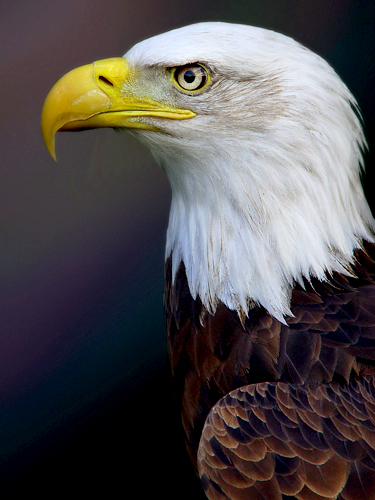Living in Balance
By Jenipher Appleton
 The bald eagle Haliaeetus leucocephalus boasts a wingspan of 183-244 cm. That translates into about seven feet! It weighs approximately 4.1 kg (10 lbs). The snow-white head and neck are distinctive. However, unlike the mature eagle, the juvenile sports a brown head and grayish eyes and could be mistaken for the golden eagle.
The bald eagle Haliaeetus leucocephalus boasts a wingspan of 183-244 cm. That translates into about seven feet! It weighs approximately 4.1 kg (10 lbs). The snow-white head and neck are distinctive. However, unlike the mature eagle, the juvenile sports a brown head and grayish eyes and could be mistaken for the golden eagle.
The bald eagle is truly at the top of its food chain. Its only threat is man, who is often responsible for loss of habitat and illegal hunting. The eyes of the adult eagle are bright yellow. When hunting, the bald eagle can focus in on prey from an unbelievable distance. This high definition sight is due to a high concentration of receptors in the retina of the eagle’s eye. Which reminds me of when my mother used to say, “I’ve got my eagle eye on you.”
She could spot anything I was doing a mile away.
Rare in eastern Canada
The bald eagle is common in Alaska and northwestern British Columbia, where up to 3000 may gather at a time to hunt salmon. They sometimes steal from ospreys (a raptor for another story). They also eat carrion and injured waterfowl, squirrels, rabbits and muskrats. Although they are not so common in eastern Canada, Steve Kozak, a citizen of Ailsa Craig who lives on the Ausable River ravine, reports a couple of recent sightings of these great birds. Steve, who watches the wildlife around him with interest, managed a good look at the birds on two separate occasions over a three-month period last year. In each case, the eagle was riding the currents over the river, searching out some unsuspecting fish.
The eagle constructs its gargantuan nest of large sticks and vegetation in the fork of a tall tree or on a ledge, sometimes 60 feet above the ground. Two bluish-white or dull white eggs are laid, 7-8 cm in length. The young, fed by both parents, stay in the nest an amazing 70-98 days. However, they have a great deal of growing to do before they become fledglings and must learn precise life skills from their parents before they can leave home forever.
Sighting can be awe-inspiring
It is not surprising that with all of these attributes that the bald eagle is often a symbol of majesty and strength. On a recent walk with my grade six students in Nairn, we were ambling through the East Williams cemetery when I happened to glance upward to spy an adult bald eagle riding the thermals of a clear blue sky. It was a breathtaking experience to be able to say, “Look! It’s a bald eagle!” I was so enraptured by the sight that I continued to walk as I was pointing aloft, and managed to slam my knee directly into a large grave marker. My apologies to the occupant. My students were suitably amused by their enthusiastic, yet absent-minded teacher.
The following week I was favoured with yet another bald eagle sighting. In early June, while out for a healthy brisk walk just north of Ailsa Craig, I caught sight of another adult male perched at the top of a tall dead tree. I stopped in my tracks and was able to observe him for about two minutes from a distance of about fifty feet. It was a most memorable and humbling experience.
These sightings may be indicators that the eastern population of bald eagles is on the increase. Keep your eyes peeled. You never know what you might see.

